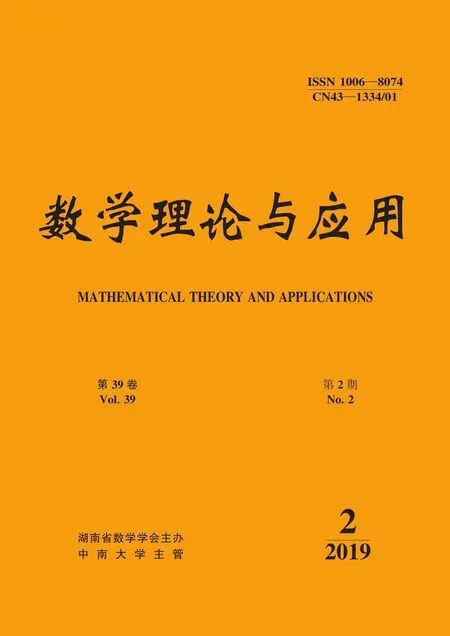Ruin Probability in the Two-Dimensional Sparre Andersen Model with Geometrical Distributed Inter-Occurrence Times
Song Yue Liu Guoxin
(School of Science, Hebei University of Technology, Tianjin 300401, China)
Abstract In this paper we consider the two-dimensional Sparre Andersen model with geometrical distributed inter-occurrence times. Firstly an exponential martingale is obtained by the extended generator. Then by applying the martingale approach and the change of probability measure the adjustment coefficient is analyzed in polar coordinates and a formula of the ruin probability and a Lundberg-type upper bound for the infinite-time ruin probability are obtained.
Key words Ruin probability Two-dimensional Sparre Andersen model Change of measure
1 Introduction
It is well known that the two-dimensional ruin theory is a natural extension of the classical ruin theory with a lot of potential applications in insurance. In two-dimensional risk models, Chan et al.[1]introduced three different types of ruin times and simple bounds for the two-dimensional ruin probabilities were obtained by using some results of one-dimensional risk processes. Li et al.[2]obtained a Lundberg-type upper bound by virtue of martingale approach for the infinite-time ruin probability bound. The multi-dimensional ruin theory has been investigated in various settings and many interesting results were obtained (see, e.g., Ambagasipitiya[3], Asmussen and Albrecher[4], Cossette and Marceau[5], Zhang and Wang[6]and Yuen et al.[7], to mention a few).
In this paper a two-dimensional Sparre Andersen model with geometrical distributed inter-occurrence times is introduced. Some similar one-dimensional risk models were concerned recently. Liu et al.[8]studied the ruin probability for continuous-time compound binomial model. Zhang et al.[9]dealt with the continuous-time compound binomial model with investment. Motivated by Liu et al.[10], we construct a suitable exponential martingale in the two-dimensional Sparre Andersen model for change of measure. It is shown that, under the new measure, the surplus process is also a two-dimensional Sparre Andersen model with geometrical distributed inter-occurrence times. It is different from Li et al.[2]that we deal with the adjustment coefficients in polar coordinates, which makes the family of adjustment coefficients and ruin probabilities to be much more intuitive. At last, a Lundberg-type bound is obtained for the two-dimensional Sparre Andersenmodel with geometrical distributed inter-occurrence times, which is parallel to the one in Li et al.[2]for the two-dimensional compound Poisson risk model.
2 The two-dimensional Sparre Andersen model with geometrical distributed inter-occurrence times
The risk surplus processR(t)=(R1(t),R2(t))Tis described as

F(t)=P(Tk>t)=(1-p)?t」,
(1)

P(Tk=n)=p(1-p)n-1,k=1,2,…;n=1,2,3,….
(2)
It implies that there is a claim with probabilityponly whentarrive at the value of integer. Then, we get the net profit condition:p1>pμ1,p2>pμ2.
3 Exponential Martingale
The extended generatorA=(Aac,Ad) of space-time process {(R1(t),R2(t))} has the following form:
(3)
(4)
wherenis an integer andΔf(x1,x2,n)=f(x1,x2,n)-f(x1,x2,n-) is the magnitude of jump.
We need to solve the equationAf(x1,x2,t)=0 if we want to find a martingale of the form {f(R1(t),R2(t),t),t≥0}. In fact we need only a special solution. Now, we try a function of the formf(x1,x2,t)=exp{-r1(x1-p1
Forn Aacf(x1,x2,t)=r1p1f(x1,x2,t)+r2p2f(x1,x2,t)-r1p1f(x1,x2,t) -r2p2f(x1,x2,t)≡0. Fort=n, we have Adf(x1,x2,n)=f(x1,x2,n)-er1p1+r2p2+θ(r1,r2)f(x1,x2,n) Hence, (5) Moreover, to show that {f(R1(t),R2(t),t)} is a martingale, we only need to justify that if f(x1,x2,t)=exp{-r1(x1-p1 then (6) SinceNt≤?t」, we have This together with the fact that |θ(r1,r2)|<∞ yield the result. Thus, we get the following theorem. Mt=exp{-r1(R1(t)-u1-p1?t」)-r2(R2(t)-u2-p2?t」)-θ(r1,r2)?t」} (7) is a martingale with the initial valueM0=1. In this section, we consider the canonical probability space (Ω,F,P) of the risk reserve process {(R1(t),R2(t)),t≥0}, whereΩis the all Borel subsets ofD(R+) consisting of all possible sample paths of {(R1(t),R2(t))} andF=B(Ω). Let {Ft} be the history of {(R1(t),R2(t))}. It is obvious that for eachn, the claim arrival timeσnis an {Ft}-stopping time. (8) Lemma 4.1For allt≥0 andA∈Ft, P(r1,r2)(A)=E[exp{-r1(R1(t)-u1-p1 -θ(r1,r2)?t」};A] (9) and P(A)=E(r1,r2)[exp{r1(R1(t)-u1-p1 +θ(r1,r2)?t」};A]. (10) Moreover, ifτis an {Ft}-stopping time andA?{τ<∞} such thatA∈Fτ, then P(r1,r2)(A)=E[exp{-r1(R1(τ)-u1-p1<τ>)-r2(R2(τ)-u2-p2<τ>)) -θ(r1,r2)?τ」};A] (11) and P(A)=E(r1,r2)[exp{r1(R1(τ)-u1-p1<τ>)+r2(R2(τ)-u2-p2<τ>) +θ(r1,r2)?τ」};A]. (12) We now show first that, under the measureP(r1,r2), the process {(R1(t),R2(t)),t≥0} remains a risk reserve process in a two-dimensional Sparre Andersen model. In particular, ProofSince the set of trajectories of the risk process {(R1(t),R2(t)),t≥0} is the same under the measurePandP(r1,r2), it is clear that the premium rate of {(R1(t),R2(t)),t≥0} is (p1,p2) under both measures. By Theorem 4.1 of Liu et al. [10] andf(x1,x2,t)=exp{-r1(x1-p1 and It follows that Then E(r1,r2)R1(1)-u1=p1-p(r1,r2)E(r1,r2)(U1) In the same way, we can get The theorem is proved. In this section, We will introduce polar coordinates and then discuss the characteristic of the functionθ(r1,r2) in polar coordinates. Let r1=ρcosα,r2=ρsinα(ρ≥0,α∈[0,2π)). Then, forρ∈R+, we have And the functionθ(ρ) is infinitely differentiable in the interval (0,ρ0). In fact, θ(ρ)=-p1ρcosα-p2ρsinα+ln(1+p(E[eρ cos αU1+ρ sin αU2]-1)) =-p1ρcosα-p2ρsinα+ln(1+p(E[eρ( cos αU1+ sin αU2)]-1)) =-p1ρcosα-p2ρsinα+ln(1+p(E[eρU]-1)), whereU= cosαU1+ sinαU2. Then the first order derivative ofθ(ρ) is And the second order derivative ofθ(ρ) is and the numerator of the right side of the equation above is pE[U2eρU](1+p(E[eρU]-1))-p2(E[UeρU])2 =p(1-p)E[U2eρU]+p2[E[U2eρU]E[eρU]-(E[UeρU])2]>0. The last inequality above follows from Schwarz’ inequality. Hence,θ(2)(ρ)>0. And this implies thatθ(ρ) is a convex function. For the first derivativeθ(1)(ρ) atρ=0 we have θ(1)(0)=(pμ1-p1) cosα+(pμ2-p2) sinα<0. It is easy to see thatθ(0)=0. Moreover, there may exist a strictly positive root ofθ(ρ)=0. If such a positive root exists, then it is unique. We call this solution, if it exists, the adjustment coefficient related toαand denote it byγ(α). θ(ρcosα,ρsinα)=0 exists a unique positive rootγ(α), and θ(1)(γ(α))>0. ProofBy the discussion above, whileρ↑ρ∞, we haveθ(ρ)=θ(ρcosα,ρsinα)↑∞. Sinceθ(0)=0,θ(1)(0)<0 and the convexity ofθ(ρ), we have θ(ρcosα,ρsinα)=0 exists a unique positive rootγ(α). Moreover θ(1)(γ(α))>0. We can use a family of adjustment coefficients to do a simple upper bound on the two-dimensional ruin probability. From above, we define the time of ruin We know thatP(γα)(τα<∞)=1. Denoteψα(u) is the infinite-time ruin probability, i.e., ψα(u)=P(τα<∞). This provides the following theorem. ψα(u) ProofRecall that, any claim arrival timeσnis at integer point, so <τα>=0. Hence, under the measureP(γα), ψα(u)=E(γα)[exp{γαcosα(R1(τα)-p1<τα>)+γαsinα(R2(τα) -p2<τα>)}]e-γαcos αu1-γαsin au2=E(γα)[exp{γαcosαR1(τα) +γαsinαR2(τα)}]e-γαcos αu1-γαsin αu2. And cosαR1(τα)+ sinαR2(τα)<0, we can get ψα(u) Let ψmax(u)=P(τmax(u)<∞), whereτmaxis the first time when bothR1(t) andR2(t) go below 0, that is, τmax(u)=inf{t>0|R(t)<0}=inf{t>0|max{R1(t),R2(t)}<0}. ProofSinceR1(τmax)<0 andR2(τmax)<0,aR1(τmax)+bR2(τmax)<0. Then, we haveτα≤τmax<∞ and ψmax(u)≤ψα(u) Andψmax(u) is independent ofα, we can get This result is parallel to Theorem 2.1 in [2] or Chapter XIII Proposition 9.3 in [4].

4 Change of Probability Measure




5 Adjustment Coefficient Family






